#World Class Driving Lessons in Pinner
Explore tagged Tumblr posts
Text
World Class Driving Lessons in Pinner
Tips for Drivers for Safe Car Driving
When you’re behind the wheel of a car – whether alone or with passengers – driving safely should always be your top concern. We’re more distracted than ever, so it’s crucial to know the basics of safe driving and practice them every time you’re on the road. Here, some Tips for Drivers for Safe Car Driving:
Drivers must know before you rev up their engines when they go. Well ordered guidelines to get from center A to center B is a driving aptitude. In the event that you direct a guide, your GPS unit or rules to know where you are going and how.
People in the driver's seat must be attentive of what is happening around them. They should reliably look in their rear-view mirrors, side mirrors, left, right and straight. Master driver to propel a sentiment of what is happening around them.

Knowing how to react to a remark completed is as basic as the time when making a beeline to react to the event. How might you turn the wheels when you start sliding on snow? When you have to wallop on the brakes, and on the off chance that they should pump? Manual is the nearest partner of all.
The associate is the best development to protect people. Drivers of the safeguard are careful and comfortable with the way that anything can occur in any heading. Drivers should reliably decide they leave enough space for their vehicles and automobiles before them to stop, if an unanticipated event, even the atmosphere.
Beyond what many would consider possible, except for when the shielded pace is slower. Rate purposes of containment are arranged in the best driving conditions. Deluge, slush, fog, and movement out on the town oblige a less demanding pace confine. Over the flood of movement is moreover a remarkable guideline.
There is no appropriate chance to make phone calls or quick messages while driving. There is no appropriate chance to make phone calls or speedy messages while driving. There is a horrendous time. Try not to do it.
Full developed drivers in all probability finished not hit the brakes to hurl rear end. They were not undermined by driving faster than is shielded. Little by little, progressively and gives a rear end go now and again meet desires. In others, simply back-end prerequisites to calm and trail as needs are.
Keeping up calm, level head works contemplate when different drivers endeavor to cut you off or drive unreasonably progressively before you. The feeling has no spot in the driver's seat of an auto.
#World Class Driving Lessons in Pinner#Driving Lessons in Pinner#Best Driving Lessons in Pinner#Pinner Driving School#Pinner Driving Lessons#pinner driving
0 notes
Text
5 Marketing Lessons from Daily Harvest’s Journey to Shipping One Million Smoothies
Launched in 2015, Daily Harvest has become one of the fastest growing direct-to-consumer food brands in the world.
In 2017, it raised over $43m — with investors like Gwyneth Paltrow and Serena Williams
It shipped over one million smoothies in just one year after launching nationwide in the U.S.
More than 100,000 customers now use its service
It’s an incredible story. But just how did Daily Harvest transition from solving a meal-prep problem for founder Rachel Drori to being in over 100,000 kitchens across the U.S.?
In this post, we take a look at some of the marketing strategies that have aided Daily Harvest’s incredible growth.
Contents: 5 Marketing Lessons from Daily Harvest
Lesson 1: Focus on target customers’ needs and create products to solve their problems
Lesson 2: Use Pinterest as a discovery engine to reach millions of potential customers each month
Lesson 3: Create a simple-to-navigate website and tell an engaging story to generate backlinks
Lesson 4: Use paid social to drive traffic to campaign-specific landing pages
Lesson 5: Build trust with new audiences through partnerships
1. Focus on target customers’ needs and create products to solve their problems
Before starting Daily Harvest, Rachel Drori worked in marketing for Jetsetter. She wanted to find a quick, convenient way to prepare her week’s meals on a Sunday, so she didn’t have to think about what she would eat during busy weekdays.
But after trying a number of options, nothing quite matched her needs.
“Meal kits are perishable, they go bad in your fridge, and they take 45 minutes to prepare,” she told Entrepreneur. “And all convenient food is preserved in some way.”
As we touched on in the intro, Daily Harvest was founded after Drori began to make meals in batch and freeze them. Something that no company seemed to be offering. Seeing a gap in the market, she pulled together a website and started selling to people who were experiencing the same meal prep problems she’d had.
The company has evolved a lot since those early days, but one thing that remains is its laser focus on serving a specific need for its target customers.
“Our target consumer is one who subscribes to a healthy lifestyle, but is busy and has time restrictions,” Drori told Business Insider.
Drori expanded on Daily Harvest’s target customer during an interview with Inc. “Our customer wants to eat the way he/shes knows he/she should, but struggles with the challenge of making it happen.”
“Our most common piece of customer feedback is that we’ve filled a need in the health food space that wasn’t previously being met. It works for the busy-bee or if you’re just looking for more nutrients in your diet but are unsure where to start.”
Consumer habits: The ease of buying healthy foods is one of the key pain points Daily Harvest solves. Shoppers want to buy healthier foods, but it’s not always easy — a survey of 1,017 U.S. consumers found that 95% of people ‘always’ or ‘sometimes’ look for healthy food options, but finding healthy food is only moderately easy for most consumers.
But why is it so important for Daily Harvest to focus on specific customers? Why doesn’t it try to entice everyone to eat a little healthier?
“Focusing on a specific customer segment is critical to sustaining long-term growth,” says DTC Strategist, Marco Marandiz.
“Organizations that get distracted easily by emerging, yet unaligned, segments end up burning through their resources and creating value that doesn’t resonate with their earliest customers,” continues Marandiz. “For Daily Harvest, it’s important for them to keep digging into their core customers to really fulfil their needs in the kitchen.”
Having a clear understanding of who its customers are, and the problems it solves for them has enabled Daily Harvest to craft messaging, content, and products that are aligned with exactly what the customer is looking for.
Right from the hero section of its homepage, you can see its focus on target customer needs and desires:
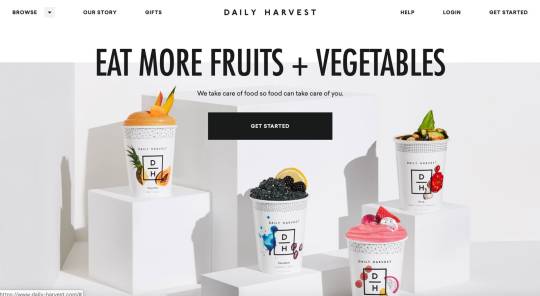
The heading ‘Eat More Fruits + Vegetables’ speaks to the target customers desire to boost their diet with healthy ingredients
The subheading ‘We take care of food so food can take care of you’ also taps into the same desires, but from a slightly different level, letting customers know that all the hard work — sourcing and preparing healthy foods — is done for them.
If you’ve ever interacted with the brand before the imagery on its site also feels incredibly familiar.
Daily Harvest has done a great job of creating its own unique brand style:
Crisp images of its packaging containing bold, brightly colored ingredients, photographed against a solid background. It also uses lighting to create shadows quite frequently.
Here’s its look on Instagram —
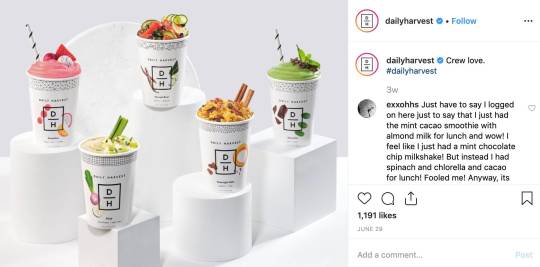
— and on a product page:
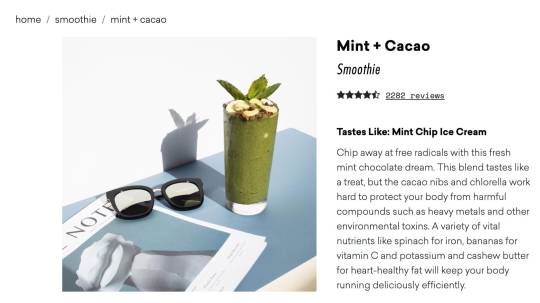
Expansion is also important for most DTC brands. Many launch with one or two specific products — for example, Casper mattresses — and expand into other related products in order to grow — Casper’s pillows and bed frames.
Daily Harvest is no different. It started out by selling frozen smoothie packs. But now it boasts a range of products.
And when it comes to launching new products, Daily Harvest ensures it keeps its focus on solving the problem of making healthy eating easier for consumers.
“It’s easy to observe their focus by taking stock of the product line expansions over the last couple years,” shares Marandiz. “They started with smoothies, but have moved into Harvest Bowls, Soups, Lattes, Chia Bowls, and Oat Bowls.”
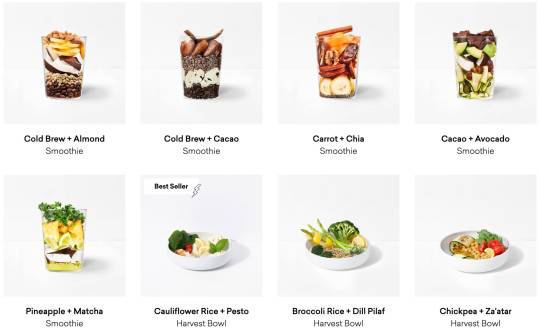
The messaging around each of its expansion products is also hyper-focused on customer goals.
Take its Harvest Bowls category page for example —

— the copy here continues to focus on the core mission of Daily Harvest: Making healthy eating simple. And no matter where you interact with the brand, that message remains consistent.
2. Use Pinterest as a discovery engine to reach millions of potential customers each month
Pinterest is somewhat of a sleeper in the social media world. And though it might not make as much noise as platforms like Facebook or Instagram, its power to help brands connect with consumers is undeniable.
In its S-1 filing ahead of going public, the company shared some insights into how people use the platform:
Pinners don’t just dream about their futures; they explore real options and often want to bring their dreams to life. They browse ideas, visit merchant websites and eventually buy products and services; and
People seeking inspiration use Pinterest in ways that mirror how they use magazines and catalogs.
So whereas consumers used to flick through magazines to find inspiration, they now turn to Pinterest — and this is why it has become such an incredible discovery engine for brands.
Daily Harvest has 5,638 followers on Pinterest. That doesn’t sound a lot, especially when compared to its audiences on Facebook (260k) and Instagram (406k). But follower numbers are just a small part of the equation.
On Pinterest, discoverability is far more important than the number of followers.
Daily Harvest racks up a mouthwatering 4.1m monthly unique viewers on Pinterest — meaning its Pins appear on over four million screens per month, and it does this having just 136 Pins.
Pinterest trends: Daily Harvest is in the perfect position to succeed on Pinterest. ‘Healthy habits’ is one of Pinterest’s trends for 2019, with searches for nutrition plans +475% year-on-year, showing that health-conscious consumers are using Pinterest to help them hit their goals.
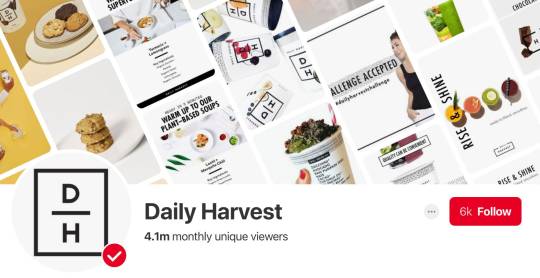
Its Pins tend to focus directly on Daily Harvest products in its brand style of stunning product imagery against a solid, light background:
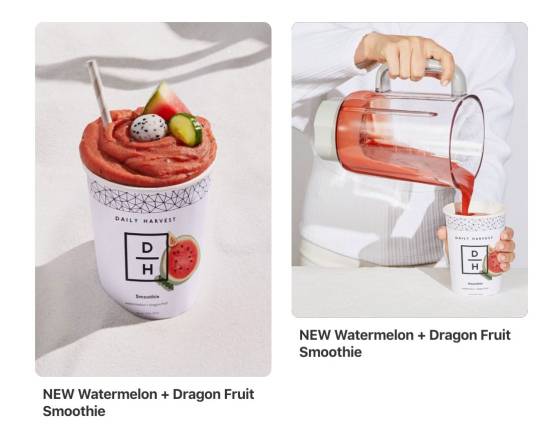
According to SimilarWeb data, Pinterest is Daily Harvest’s third-highest refer amongst social networks, driving around 13,000 visits per month —
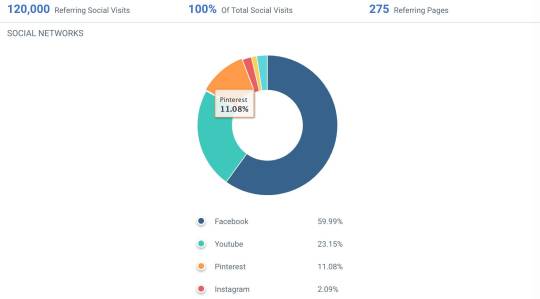
— and much of this traffic is going directly to product pages (the link on each Pin takes the viewer to the corresponding page):
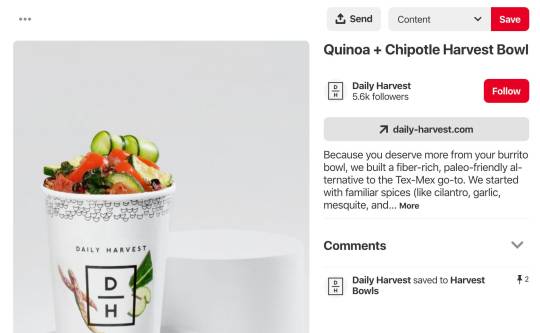
3. Create a simple-to-navigate website and tell an engaging story to generate backlinks
SimilarWeb estimates that over 30% of Daily Harvest’s traffic comes from search —

— that’s a pretty large chunk, and if SimilarWeb’s estimates are correct, that search traffic equates to around 270,000 visits per month for the brand. That’s a lot of potential customers.
So what can we take away from Daily Harvest’s search success?
Firstly, usability and design are important:
“The design, first of all, is obviously incredible. While I never consider design to be a direct SEO factor, having a positive experience on a site does make you more likely to talk about and link to it,” says Glen Allsopp, SEO consultant and founder of Detailed.com.
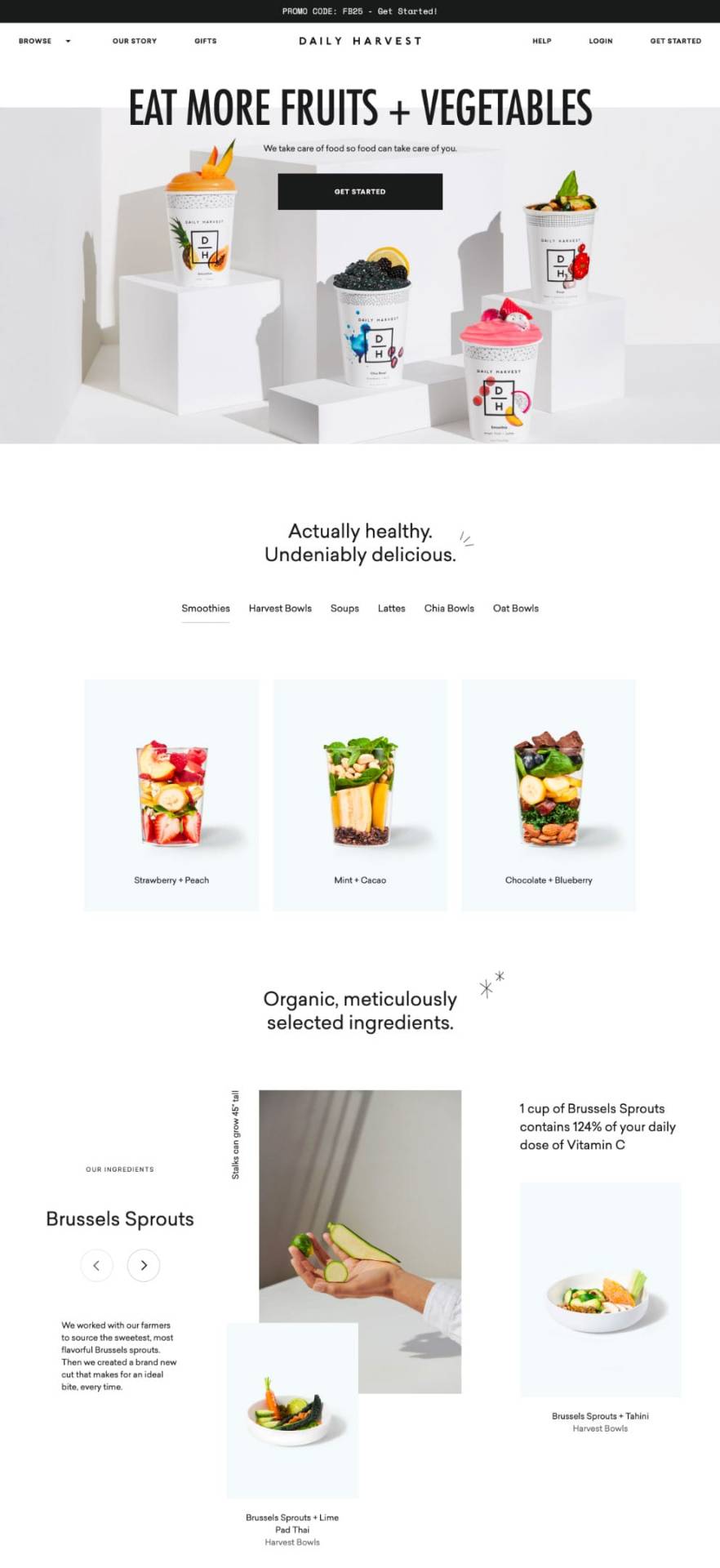
And Allsopp certainly isn’t alone in praising Daily Harvest’s design, Unbounce has also featured it in its roundup of companies that have created best-in-class landing pages.
But back to SEO…
Simplicity is somewhat of a theme for Daily Harvest across its website, content and even its products — pre-made, healthy meals that are ready in minutes.
And this theme carries over into its approach to SEO.
“I like that their URLs are short and descriptive, which is in line with their title tags as well,” notes Allsopp. “Title tags don’t get much more simple and clean than ‘Lentil + Mesquite Soup | Daily Harvest’.”
Daily Harvest also manages to include plenty of information on its product pages, something that’s not easy to do well Allsopp told me. First, each product has a short description right under the title —
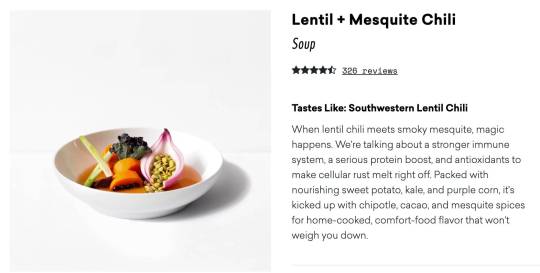
— a little further down the page, visitors can see key ingredients, nutrition information and preparation instructions — essentially everything a customer would want to know about this product, without it feeling overwhelming:
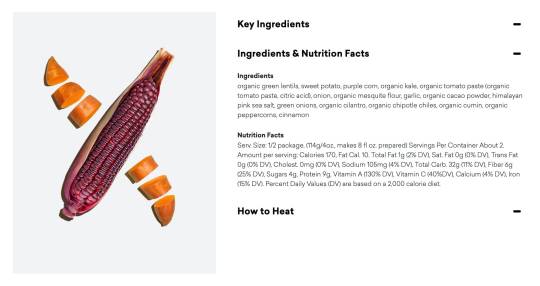
One downside to Daily Harvest’s beautiful imagery is the effect it has on load times. “According to Google’s mobile site speed comparison tool, it’s a lot slower than competitors sites,” Allsopp shared.
But with much of its search traffic coming in via branded searches, Daily Harvest has done a great job building its brand and creating a loyal customer base:
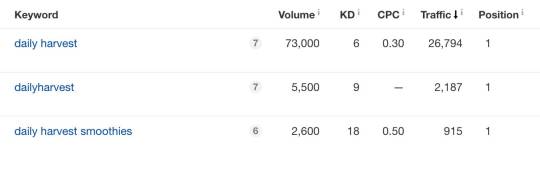
Possibly Daily Harvest’s biggest SEO-win is the quality of backlinks it has been able to obtain from leading publications — something that’s a challenge for almost every business.
Link building is one of the hardest aspects of SEO — and I have no insider knowledge here — but I’d bet Daily Harvest has never sent out a batch of emails asking marketers to backlink to its site.
Instead, it does link building the right way, by telling its story… and having a great product.
“Daily Harvest’s founder, Rachel Drori, has been great at getting quoted in big publications,” Allsopp told me. “Some places that have asked her for comment include CNBC and The New York Times. Those aren’t easy links to get, so they’re likely to help the site for a long time to come.”

Because its products are high-quality and deliver on what it promises, it’s enabled Daily Harvest to be featured by industry experts and pick up links from high-authority sites like MSN:
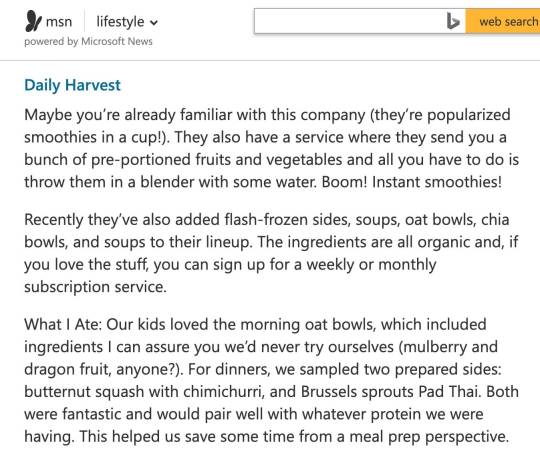
“While they still have improvements to make with their on-site SEO, that’s always a great position to be in. Seeing opportunities for improvement there means there’s a good chance of growing organic traffic across the board going forward as well,” said Allsopp.
4. Use paid social to drive traffic to campaign-specific landing pages
When Daily Harvest runs ads, it doesn’t direct people to its homepage. Instead, it has a specially created landing page aimed to convert visitors to customers.
This isn’t a unique strategy. In-fact, creating specific landing pages for ads is a best practice for any brand investing in paid media. But the way Daily Harvest executes it is remarkable.
Here’s one of the brand’s landing pages:
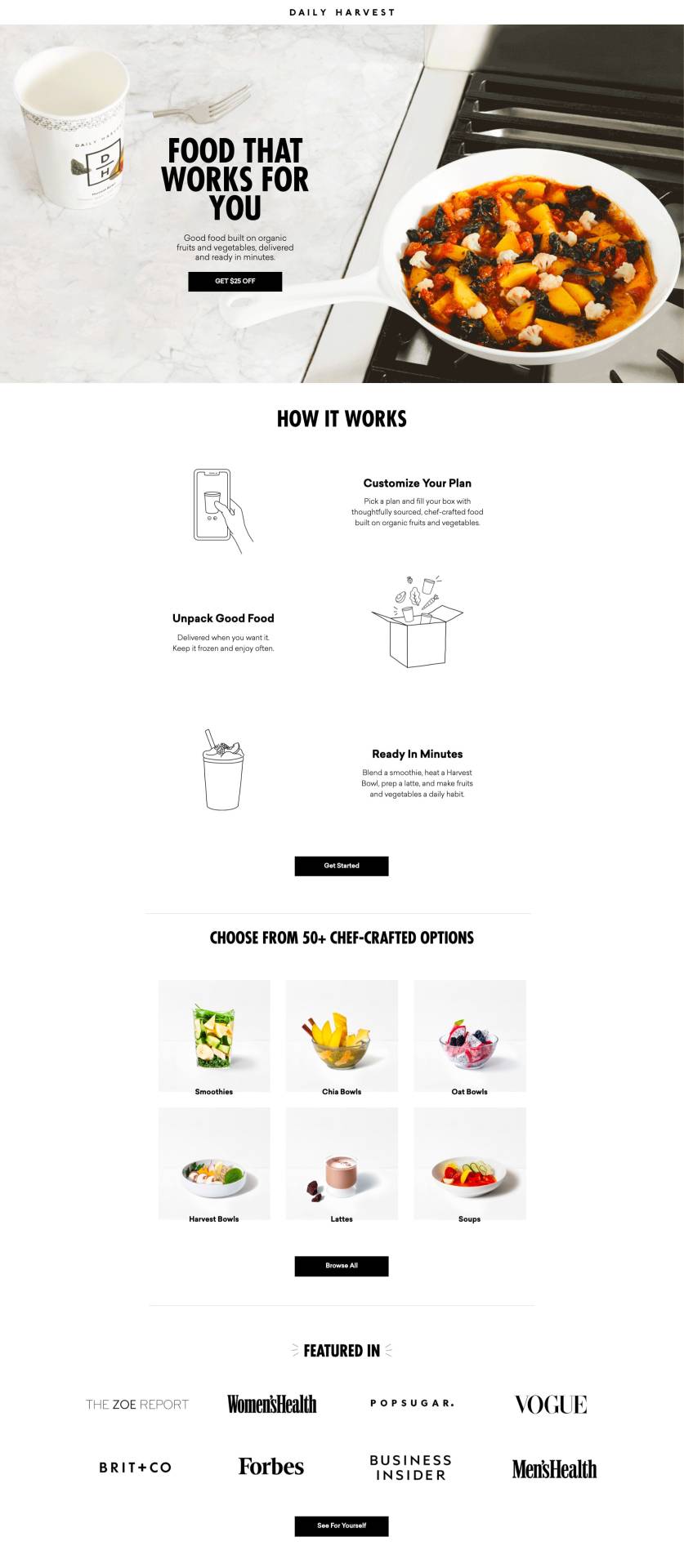
Keeping in line with Daily Harvest’s beautiful design aesthetic, the page looks super-clean and simple. But when you really dig in, there’s a lot going on.
Here are four takeaways from Daily Harvest’s landing page:
1. The hero copy builds on ad promises
Let’s start by breaking down the hero section at the top of the page:
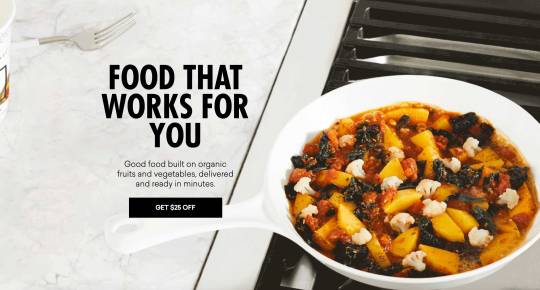
Daily Harvest is running a bunch of ads across Facebook and Instagram, and many of its ads are focused on these key messages:
Custom food plans
Quality, organic fruits and vegetables
Speed of preparation
Here are a few variations of that messaging in ad form:
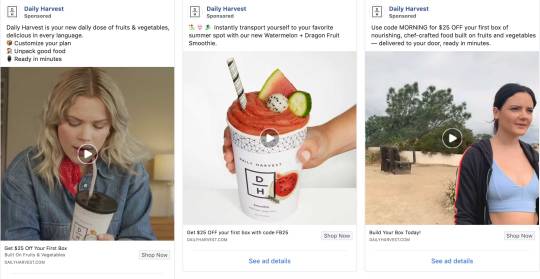
Once someone has clicked one of these ads, they arrive at one of Daily Harvest’s landing pages and the copy builds on the key points mentioned in the ads. It reinforces that:
The food is high quality, and good for you
It’s ready in minutes
Health eating that fits your routine
2. The CTA offer is very clear
In each of its ads, Daily Harvest mentions that new customers can get $25 off their first box using a promo code —
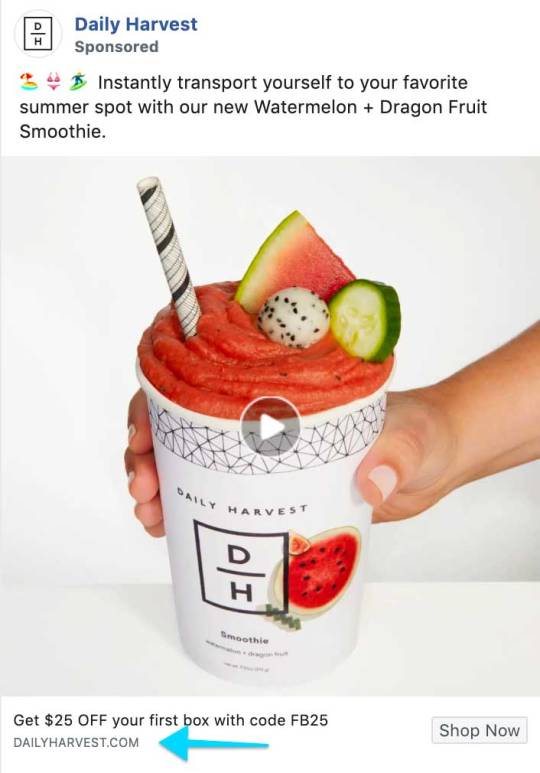
— and when they reach the landing page, this 25% offer is featured in the hero section CTA:
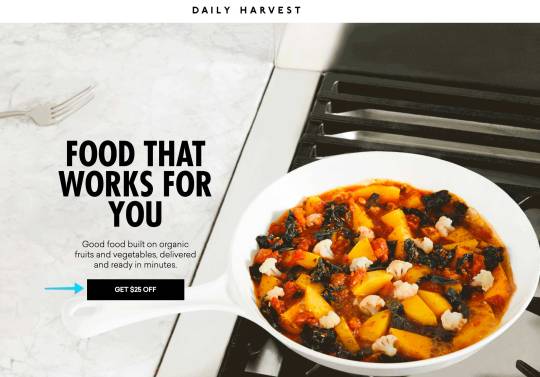
This makes the buyer journey feel super smooth as promises that were made in the first part of the journey (the ads) are being backed up as people move through the buying experience.
3. The copy is all about you, the customer
As the visitor scrolls through the landing page they reach a ‘How it works’ section:
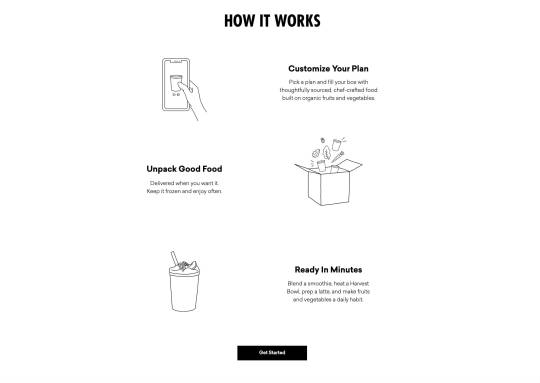
The first title tag ‘Customize Your Plan’ puts the emphasis on you, the potential customer, and throughout this section of the landing page the reader is constantly reminded that Daily Harvest is a product that can solve your unmet needs.
Here are a few snippets of copy (emphasis mine):
Pick a plan and fill your box with thoughtfully sourced, chef-crafted food
Delivered when you want it
Make fruits and vegetables a daily habit
This copy also fulfils a need to let the customer know exactly how the process works. Many visitors want a hassle-free way to consume healthier foods, but prior to visiting this page may not understand how Daily Harvest delivers on this.
Pay attention to the small details: Microcopy — the small pieces of text that provide extra information and provide context across websites and interfaces — is incredibly important, and can have a big influence on clicks and conversions.
For example, one company found that changing the phrase “Request a quote” to “Request pricing” resulted 161.66% increase in clicks to its lead gen form.
4. It uses social proof to back up its message
Social proof is a powerful sales tool and helps to build trust. As Alfred explains in his post on the subject:
“Often in situations where we are uncertain about what to do, we would assume that the people around us(experts, celebrities, friends, etc.) have more knowledge about what’s going on and what should be done.”
As a prospective Daily Harvest customer, I might not be an expert on healthy eating, I just know I want to eat healthier. So to back up its message, Daily Harvest features a range of well-known publishers that have covered its products to help build trust:

You’re more likely to put your faith in a health product featured by Men’s Health, Women’s Health and Vogue, than one no publisher has featured, right?
5. Build trust with new audiences through partnerships
Partnerships have become a key part of the direct-to-consumer marketing playbook.
Why?
In its simplest form, advertising is about connecting relevant audiences with your message. But when marketers focus purely on reach they run into a problem: reach has become a commodity — anyone can now create a Facebook ad and put it in front of an audience.
As Morgan Housel wrote —
Attracting eyeballs no longer sets you apart. Building trust among those who have their eyes on you, does. Getting people’s attention is no longer a skill. Keeping people’s attention is.
— and this is where partnerships come into their own: Building trust.
Let me explain…
When you follow a YouTuber, let’s say Casey Neistat, he’s built up your trust over hundreds (if not thousands) of hours of content and attention.
So when a brand like Samsung works with Casey, it helps the brand to build trust with Casey’s audience.
“If Samsung is cool with Casey, it’s cool with me.”

Daily Harvest takes a similar approach to partnerships….
YouTube drives significant traffic for Daily Harvest. You might recognize the below chart from earlier, but this time I’ve highlighted the YouTube numbers —
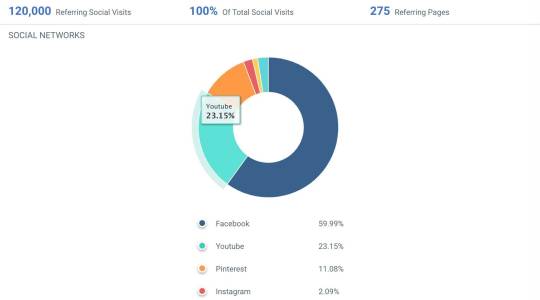
— around 23% of Daily Harvest’s social traffic comes from YouTube.
Curious as to why so many people come from YouTube to Daily Harvest I done a little digging… and it seems partnerships have a lot to do with it.
One the YouTube pages that appears to be sending a lot of traffic to Daily Harvest is from popular YouTuber, Wheezy Waiter (nearly 900k subs!):
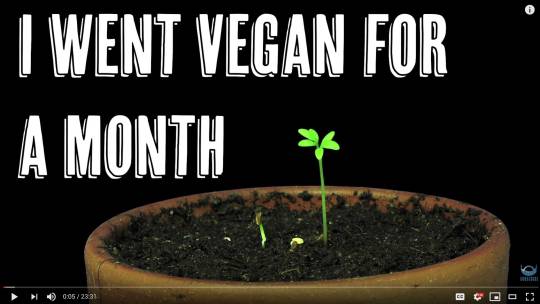
The video (as you can probably guess from the above screenshot) is about the host’s experience trying out a vegan diet for a month.
And as the video progresses, the host runs into a problem with finding vegan desserts he likes. But Daily Harvest, the video’s sponsor, sent him 24 smoothies to help solve his problem:
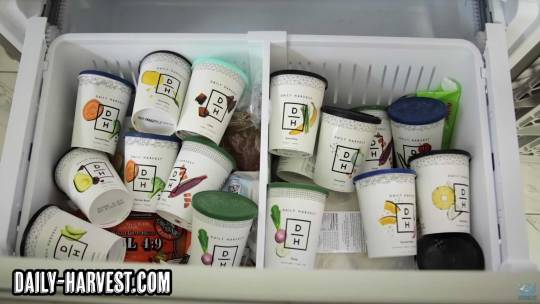
Incredible product placement (this video has been watched 1.5 million times and counting) but it doesn’t end there. In the video description there’s a link to Daily Harvest’s website:
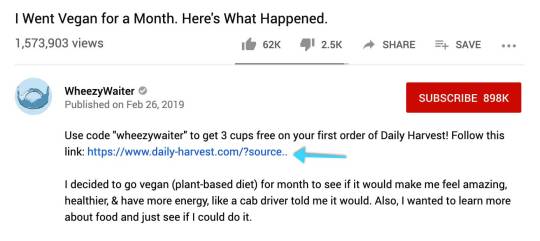
The link also has a UTM specific to Wheezy Waiter so the Daily Harvest team will be able to attribute traffic and sales to this partnership:
https://www.daily-harvest.com/?source=youtube&medium=cpc&campaign=inf&content=wheezywaiter&term=
Breaking down the UTM: Essentially, UTM codes tell the story of how traffic is arriving at a website. Here’s a breakdown of the Daily Harvest UTM:
source=youtube: This tells Daily Harvest the traffic has been referred by YouTube
medium=cpc: Says this was a cost-per-click campaign
content=wheezywaiter: Lets the Daily Harvest team know exactly which piece of content creator the traffic is came from
This is something Daily Harvest has done with a number of well-established YouTuber’s:
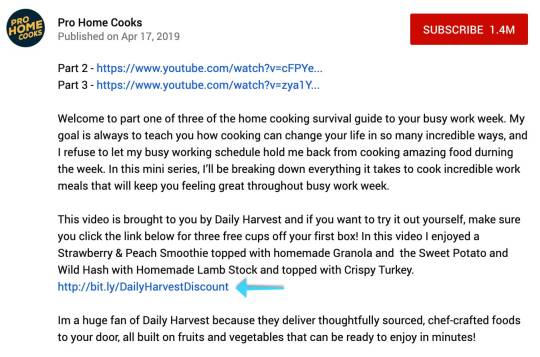
And:

But Daily Harvest’s partnerships aren’t limited to YouTube. It regularly runs Instagram takeovers with influencers and other brands in its stories —

— and it also has an ambassador program enabling people with large followings to share exclusive discounts and coupon codes with their audiences:
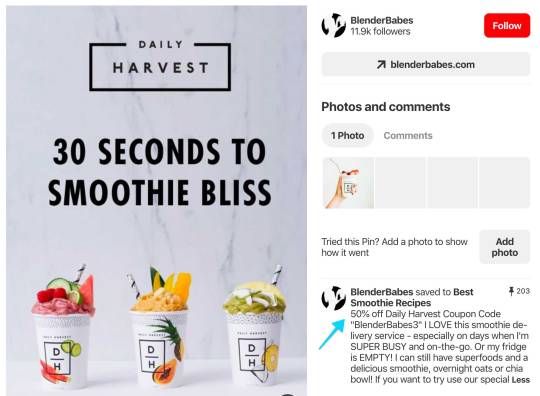
Daily Harvest is also very forthcoming with partnerships. Its website footer features a ‘Partnerships’ link:
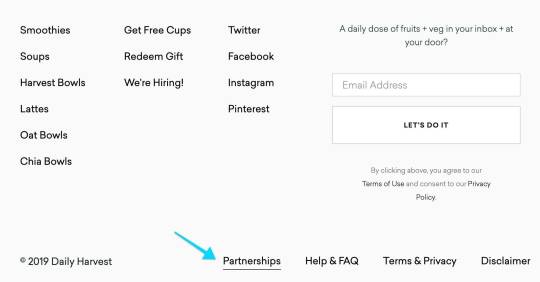
This link then takes people to a simple form where they can register their interest in working with the brand:
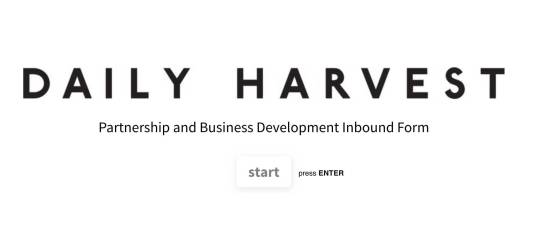
5 Takeaways from Daily Harvest’s journey to 100,000+ customers
1. Understand your target customer’s unmet needs:
Daily Harvest has a clear understanding of who its customer is exactly and what problems it solves for them. This influences how the whole business works: From its product lines to how it positions itself in the market.
2. Use Pinterest as a discovery engine:
Pinterest is a discovery engine for brands. People use Pinterest in ways that mirror how they use magazines and catalogs. By posting relevant content Daily Harvest reaches over four million people per month on the platform.
3. Create a beautiful, simple-to-use buying experience:
Consumers are spoilt for choice now, to stand out you need to create great experiences. Daily Harvest’s website does just that. Its focus on story has also helped the company to pick up some very important backlinks.
4. Drive paid social traffic to specific landing pages:
When using paid acquisition channels (especially on social media), Daily Harvest links to specific landing pages that build on the promises made in the ads.
5. Unlock new audiences through strategic partnerships:
When you’re marketing to new audiences, it’s not so much about reach as it is building trust. Daily Harvest works with partners and influencers to help it establish trust with new potential customers.
5 Marketing Lessons from Daily Harvest’s Journey to Shipping One Million Smoothies published first on https://improfitninja.weebly.com/
0 notes
Text
5 Marketing Lessons from Daily Harvest’s Journey to Shipping One Million Smoothies
Launched in 2015, Daily Harvest has become one of the fastest growing direct-to-consumer food brands in the world.
In 2017, it raised over $43m — with investors like Gwyneth Paltrow and Serena Williams
It shipped over one million smoothies in just one year after launching nationwide in the U.S.
More than 100,000 customers now use its service
It’s an incredible story. But just how did Daily Harvest transition from solving a meal-prep problem for founder Rachel Drori to being in over 100,000 kitchens across the U.S.?
In this post, we take a look at some of the marketing strategies that have aided Daily Harvest’s incredible growth.
Contents: 5 Marketing Lessons from Daily Harvest
Lesson 1: Focus on target customers’ needs and create products to solve their problems
Lesson 2: Use Pinterest as a discovery engine to reach millions of potential customers each month
Lesson 3: Create a simple-to-navigate website and tell an engaging story to generate backlinks
Lesson 4: Use paid social to drive traffic to campaign-specific landing pages
Lesson 5: Build trust with new audiences through partnerships
1. Focus on target customers’ needs and create products to solve their problems
Before starting Daily Harvest, Rachel Drori worked in marketing for Jetsetter. She wanted to find a quick, convenient way to prepare her week’s meals on a Sunday, so she didn’t have to think about what she would eat during busy weekdays.
But after trying a number of options, nothing quite matched her needs.
“Meal kits are perishable, they go bad in your fridge, and they take 45 minutes to prepare,” she told Entrepreneur. “And all convenient food is preserved in some way.”
As we touched on in the intro, Daily Harvest was founded after Drori began to make meals in batch and freeze them. Something that no company seemed to be offering. Seeing a gap in the market, she pulled together a website and started selling to people who were experiencing the same meal prep problems she’d had.
The company has evolved a lot since those early days, but one thing that remains is its laser focus on serving a specific need for its target customers.
“Our target consumer is one who subscribes to a healthy lifestyle, but is busy and has time restrictions,” Drori told Business Insider.
Drori expanded on Daily Harvest’s target customer during an interview with Inc. “Our customer wants to eat the way he/shes knows he/she should, but struggles with the challenge of making it happen.”
“Our most common piece of customer feedback is that we’ve filled a need in the health food space that wasn’t previously being met. It works for the busy-bee or if you’re just looking for more nutrients in your diet but are unsure where to start.”
Consumer habits: The ease of buying healthy foods is one of the key pain points Daily Harvest solves. Shoppers want to buy healthier foods, but it’s not always easy — a survey of 1,017 U.S. consumers found that 95% of people ‘always’ or ‘sometimes’ look for healthy food options, but finding healthy food is only moderately easy for most consumers.
But why is it so important for Daily Harvest to focus on specific customers? Why doesn’t it try to entice everyone to eat a little healthier?
“Focusing on a specific customer segment is critical to sustaining long-term growth,” says DTC Strategist, Marco Marandiz.
“Organizations that get distracted easily by emerging, yet unaligned, segments end up burning through their resources and creating value that doesn’t resonate with their earliest customers,” continues Marandiz. “For Daily Harvest, it’s important for them to keep digging into their core customers to really fulfil their needs in the kitchen.”
Having a clear understanding of who its customers are, and the problems it solves for them has enabled Daily Harvest to craft messaging, content, and products that are aligned with exactly what the customer is looking for.
Right from the hero section of its homepage, you can see its focus on target customer needs and desires:
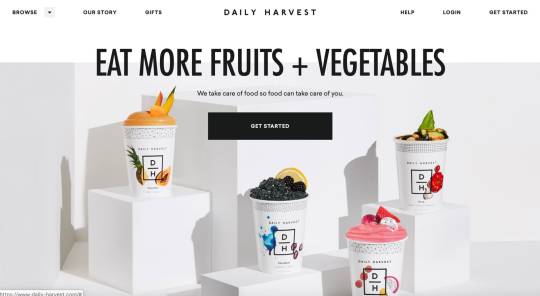
The heading ‘Eat More Fruits + Vegetables’ speaks to the target customers desire to boost their diet with healthy ingredients
The subheading ‘We take care of food so food can take care of you’ also taps into the same desires, but from a slightly different level, letting customers know that all the hard work — sourcing and preparing healthy foods — is done for them.
If you’ve ever interacted with the brand before the imagery on its site also feels incredibly familiar.
Daily Harvest has done a great job of creating its own unique brand style:
Crisp images of its packaging containing bold, brightly colored ingredients, photographed against a solid background. It also uses lighting to create shadows quite frequently.
Here’s its look on Instagram —
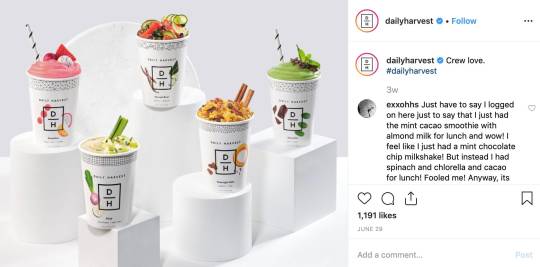
— and on a product page:
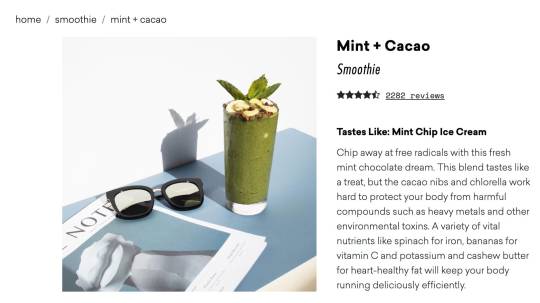
Expansion is also important for most DTC brands. Many launch with one or two specific products — for example, Casper mattresses — and expand into other related products in order to grow — Casper’s pillows and bed frames.
Daily Harvest is no different. It started out by selling frozen smoothie packs. But now it boasts a range of products.
And when it comes to launching new products, Daily Harvest ensures it keeps its focus on solving the problem of making healthy eating easier for consumers.
“It’s easy to observe their focus by taking stock of the product line expansions over the last couple years,” shares Marandiz. “They started with smoothies, but have moved into Harvest Bowls, Soups, Lattes, Chia Bowls, and Oat Bowls.”
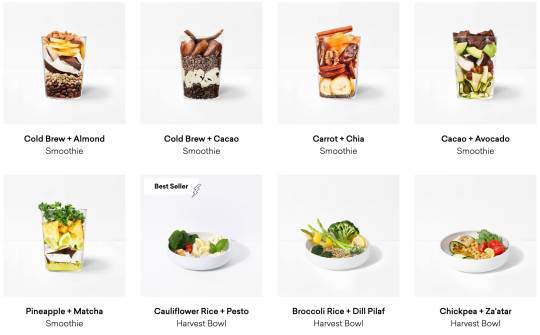
The messaging around each of its expansion products is also hyper-focused on customer goals.
Take its Harvest Bowls category page for example —
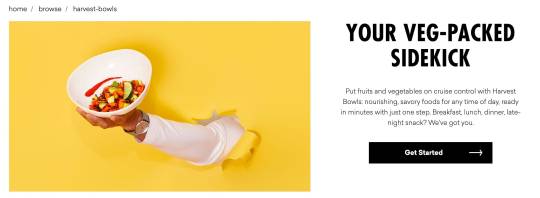
— the copy here continues to focus on the core mission of Daily Harvest: Making healthy eating simple. And no matter where you interact with the brand, that message remains consistent.
2. Use Pinterest as a discovery engine to reach millions of potential customers each month
Pinterest is somewhat of a sleeper in the social media world. And though it might not make as much noise as platforms like Facebook or Instagram, its power to help brands connect with consumers is undeniable.
In its S-1 filing ahead of going public, the company shared some insights into how people use the platform:
Pinners don’t just dream about their futures; they explore real options and often want to bring their dreams to life. They browse ideas, visit merchant websites and eventually buy products and services; and
People seeking inspiration use Pinterest in ways that mirror how they use magazines and catalogs.
So whereas consumers used to flick through magazines to find inspiration, they now turn to Pinterest — and this is why it has become such an incredible discovery engine for brands.
Daily Harvest has 5,638 followers on Pinterest. That doesn’t sound a lot, especially when compared to its audiences on Facebook (260k) and Instagram (406k). But follower numbers are just a small part of the equation.
On Pinterest, discoverability is far more important than the number of followers.
Daily Harvest racks up a mouthwatering 4.1m monthly unique viewers on Pinterest — meaning its Pins appear on over four million screens per month, and it does this having just 136 Pins.
Pinterest trends: Daily Harvest is in the perfect position to succeed on Pinterest. ‘Healthy habits’ is one of Pinterest’s trends for 2019, with searches for nutrition plans +475% year-on-year, showing that health-conscious consumers are using Pinterest to help them hit their goals.
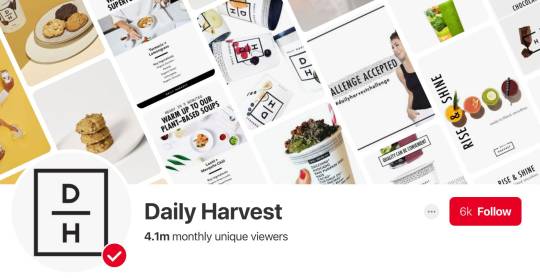
Its Pins tend to focus directly on Daily Harvest products in its brand style of stunning product imagery against a solid, light background:
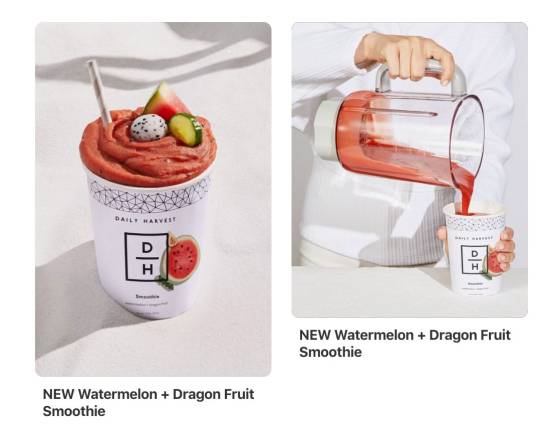
According to SimilarWeb data, Pinterest is Daily Harvest’s third-highest refer amongst social networks, driving around 13,000 visits per month —
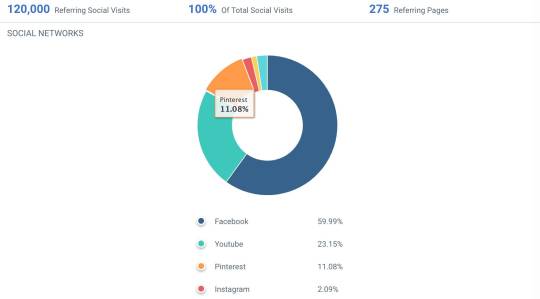
— and much of this traffic is going directly to product pages (the link on each Pin takes the viewer to the corresponding page):
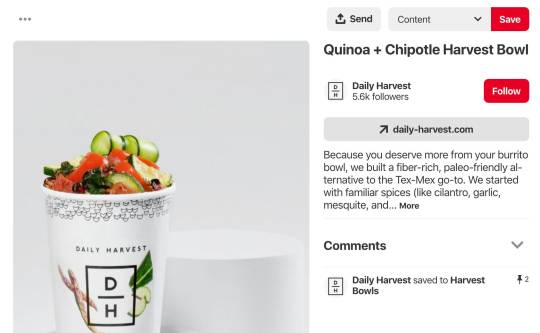
3. Create a simple-to-navigate website and tell an engaging story to generate backlinks
SimilarWeb estimates that over 30% of Daily Harvest’s traffic comes from search —

— that’s a pretty large chunk, and if SimilarWeb’s estimates are correct, that search traffic equates to around 270,000 visits per month for the brand. That’s a lot of potential customers.
So what can we take away from Daily Harvest’s search success?
Firstly, usability and design are important:
“The design, first of all, is obviously incredible. While I never consider design to be a direct SEO factor, having a positive experience on a site does make you more likely to talk about and link to it,” says Glen Allsopp, SEO consultant and founder of Detailed.com.
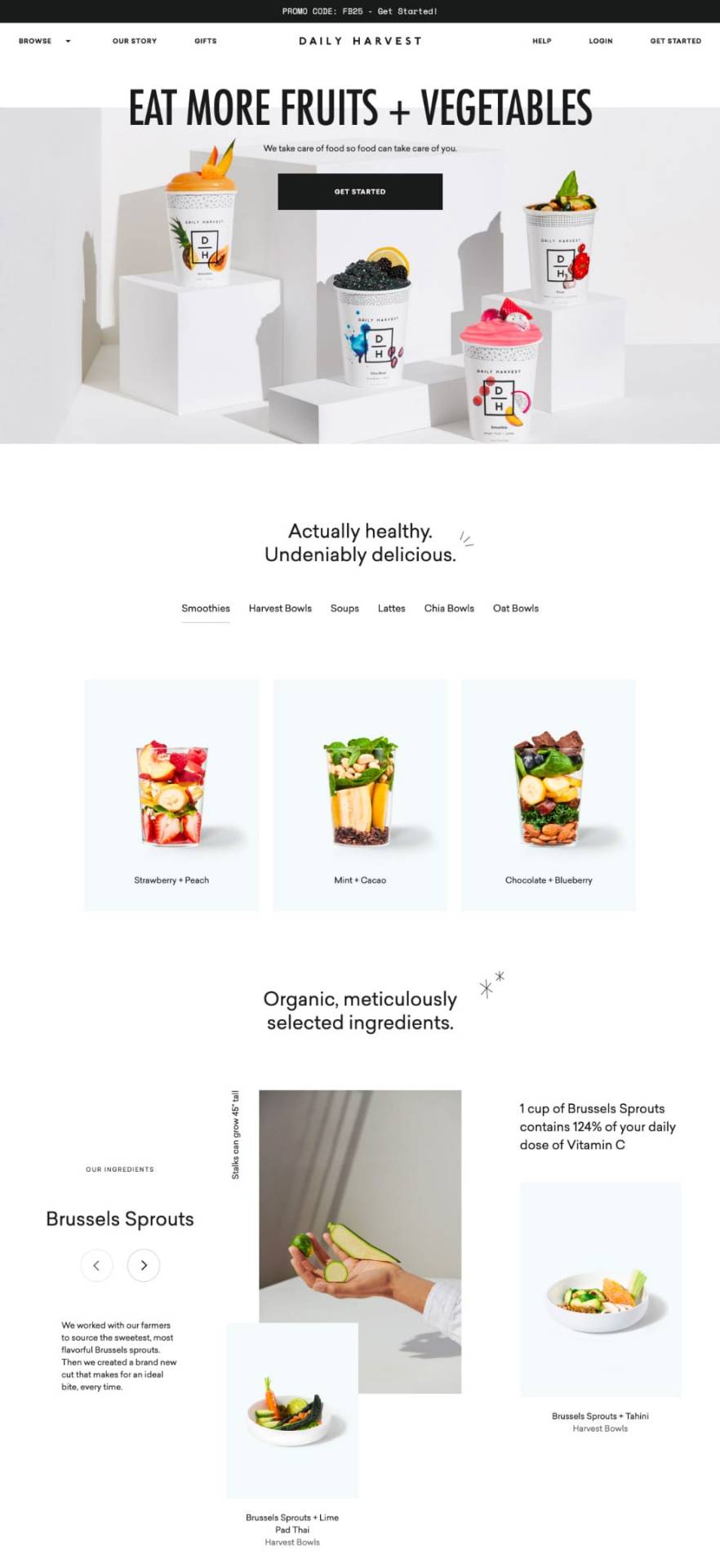
And Allsopp certainly isn’t alone in praising Daily Harvest’s design, Unbounce has also featured it in its roundup of companies that have created best-in-class landing pages.
But back to SEO…
Simplicity is somewhat of a theme for Daily Harvest across its website, content and even its products — pre-made, healthy meals that are ready in minutes.
And this theme carries over into its approach to SEO.
“I like that their URLs are short and descriptive, which is in line with their title tags as well,” notes Allsopp. “Title tags don’t get much more simple and clean than ‘Lentil + Mesquite Soup | Daily Harvest’.”
Daily Harvest also manages to include plenty of information on its product pages, something that’s not easy to do well Allsopp told me. First, each product has a short description right under the title —
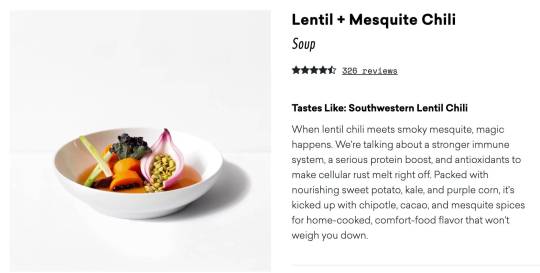
— a little further down the page, visitors can see key ingredients, nutrition information and preparation instructions — essentially everything a customer would want to know about this product, without it feeling overwhelming:
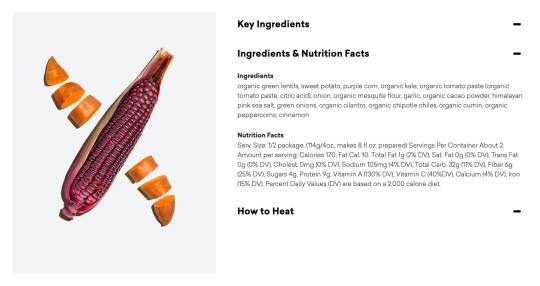
One downside to Daily Harvest’s beautiful imagery is the effect it has on load times. “According to Google’s mobile site speed comparison tool, it’s a lot slower than competitors sites,” Allsopp shared.
But with much of its search traffic coming in via branded searches, Daily Harvest has done a great job building its brand and creating a loyal customer base:
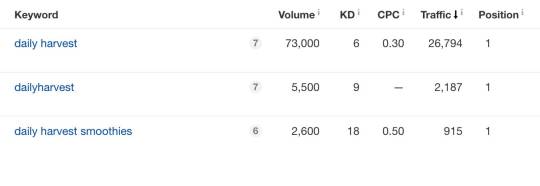
Possibly Daily Harvest’s biggest SEO-win is the quality of backlinks it has been able to obtain from leading publications — something that’s a challenge for almost every business.
Link building is one of the hardest aspects of SEO — and I have no insider knowledge here — but I’d bet Daily Harvest has never sent out a batch of emails asking marketers to backlink to its site.
Instead, it does link building the right way, by telling its story… and having a great product.
“Daily Harvest’s founder, Rachel Drori, has been great at getting quoted in big publications,” Allsopp told me. “Some places that have asked her for comment include CNBC and The New York Times. Those aren’t easy links to get, so they’re likely to help the site for a long time to come.”

Because its products are high-quality and deliver on what it promises, it’s enabled Daily Harvest to be featured by industry experts and pick up links from high-authority sites like MSN:
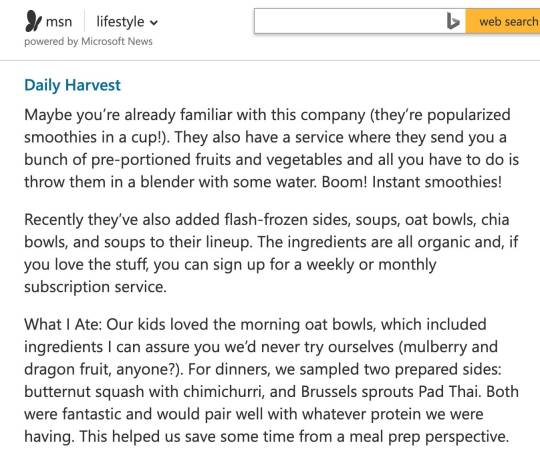
“While they still have improvements to make with their on-site SEO, that’s always a great position to be in. Seeing opportunities for improvement there means there’s a good chance of growing organic traffic across the board going forward as well,” said Allsopp.
4. Use paid social to drive traffic to campaign-specific landing pages
When Daily Harvest runs ads, it doesn’t direct people to its homepage. Instead, it has a specially created landing page aimed to convert visitors to customers.
This isn’t a unique strategy. In-fact, creating specific landing pages for ads is a best practice for any brand investing in paid media. But the way Daily Harvest executes it is remarkable.
Here’s one of the brand’s landing pages:
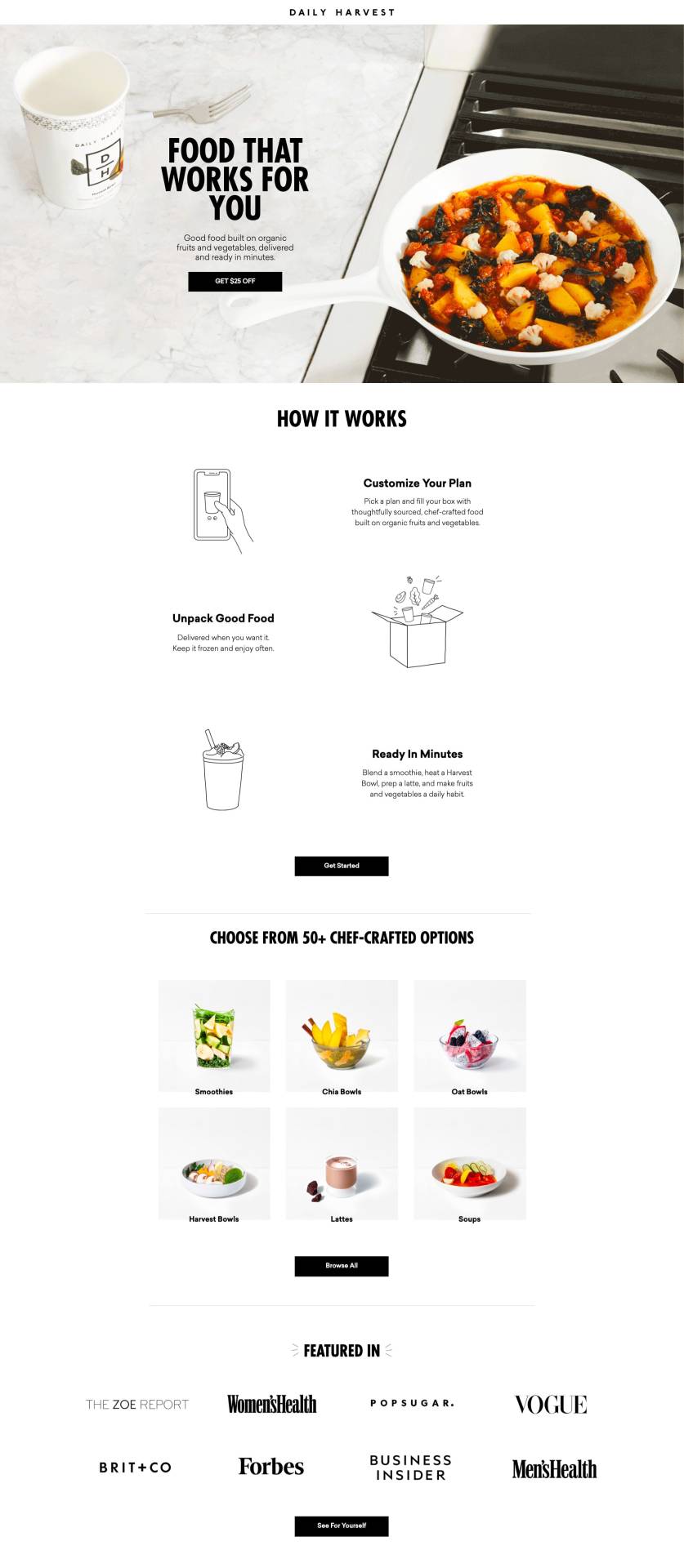
Keeping in line with Daily Harvest’s beautiful design aesthetic, the page looks super-clean and simple. But when you really dig in, there’s a lot going on.
Here are four takeaways from Daily Harvest’s landing page:
1. The hero copy builds on ad promises
Let’s start by breaking down the hero section at the top of the page:
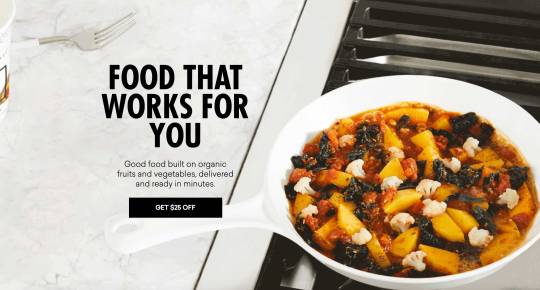
Daily Harvest is running a bunch of ads across Facebook and Instagram, and many of its ads are focused on these key messages:
Custom food plans
Quality, organic fruits and vegetables
Speed of preparation
Here are a few variations of that messaging in ad form:
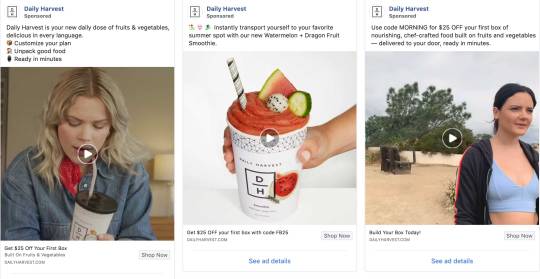
Once someone has clicked one of these ads, they arrive at one of Daily Harvest’s landing pages and the copy builds on the key points mentioned in the ads. It reinforces that:
The food is high quality, and good for you
It’s ready in minutes
Health eating that fits your routine
2. The CTA offer is very clear
In each of its ads, Daily Harvest mentions that new customers can get $25 off their first box using a promo code —
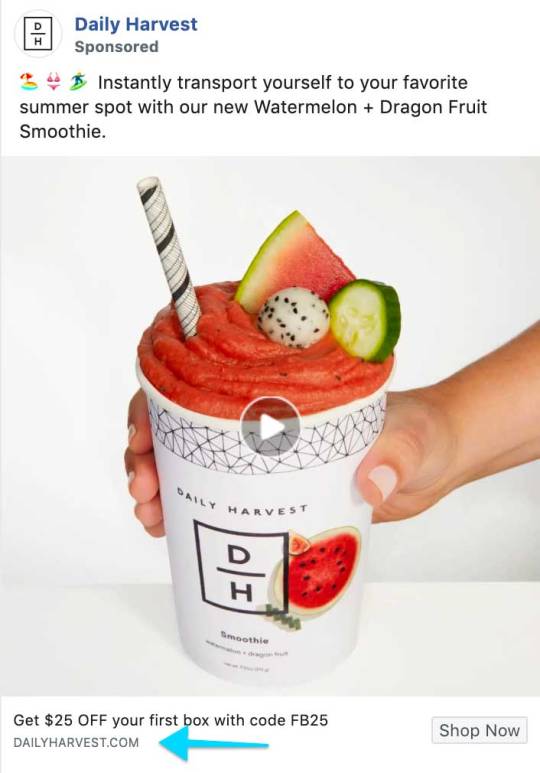
— and when they reach the landing page, this 25% offer is featured in the hero section CTA:
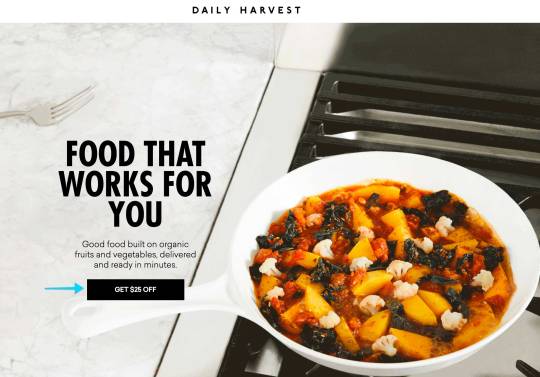
This makes the buyer journey feel super smooth as promises that were made in the first part of the journey (the ads) are being backed up as people move through the buying experience.
3. The copy is all about you, the customer
As the visitor scrolls through the landing page they reach a ‘How it works’ section:

The first title tag ‘Customize Your Plan’ puts the emphasis on you, the potential customer, and throughout this section of the landing page the reader is constantly reminded that Daily Harvest is a product that can solve your unmet needs.
Here are a few snippets of copy (emphasis mine):
Pick a plan and fill your box with thoughtfully sourced, chef-crafted food
Delivered when you want it
Make fruits and vegetables a daily habit
This copy also fulfils a need to let the customer know exactly how the process works. Many visitors want a hassle-free way to consume healthier foods, but prior to visiting this page may not understand how Daily Harvest delivers on this.
Pay attention to the small details: Microcopy — the small pieces of text that provide extra information and provide context across websites and interfaces — is incredibly important, and can have a big influence on clicks and conversions.
For example, one company found that changing the phrase “Request a quote” to “Request pricing” resulted 161.66% increase in clicks to its lead gen form.
4. It uses social proof to back up its message
Social proof is a powerful sales tool and helps to build trust. As Alfred explains in his post on the subject:
“Often in situations where we are uncertain about what to do, we would assume that the people around us(experts, celebrities, friends, etc.) have more knowledge about what’s going on and what should be done.”
As a prospective Daily Harvest customer, I might not be an expert on healthy eating, I just know I want to eat healthier. So to back up its message, Daily Harvest features a range of well-known publishers that have covered its products to help build trust:

You’re more likely to put your faith in a health product featured by Men’s Health, Women’s Health and Vogue, than one no publisher has featured, right?
5. Build trust with new audiences through partnerships
Partnerships have become a key part of the direct-to-consumer marketing playbook.
Why?
In its simplest form, advertising is about connecting relevant audiences with your message. But when marketers focus purely on reach they run into a problem: reach has become a commodity — anyone can now create a Facebook ad and put it in front of an audience.
As Morgan Housel wrote —
Attracting eyeballs no longer sets you apart. Building trust among those who have their eyes on you, does. Getting people’s attention is no longer a skill. Keeping people’s attention is.
— and this is where partnerships come into their own: Building trust.
Let me explain…
When you follow a YouTuber, let’s say Casey Neistat, he’s built up your trust over hundreds (if not thousands) of hours of content and attention.
So when a brand like Samsung works with Casey, it helps the brand to build trust with Casey’s audience.
“If Samsung is cool with Casey, it’s cool with me.”

Daily Harvest takes a similar approach to partnerships….
YouTube drives significant traffic for Daily Harvest. You might recognize the below chart from earlier, but this time I’ve highlighted the YouTube numbers —
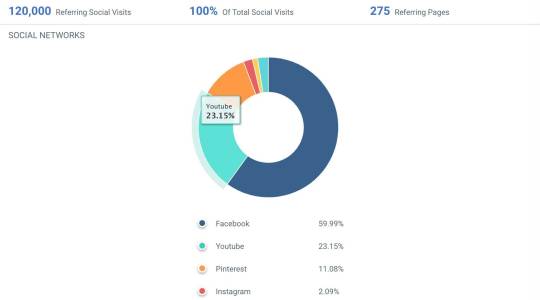
— around 23% of Daily Harvest’s social traffic comes from YouTube.
Curious as to why so many people come from YouTube to Daily Harvest I done a little digging… and it seems partnerships have a lot to do with it.
One the YouTube pages that appears to be sending a lot of traffic to Daily Harvest is from popular YouTuber, Wheezy Waiter (nearly 900k subs!):
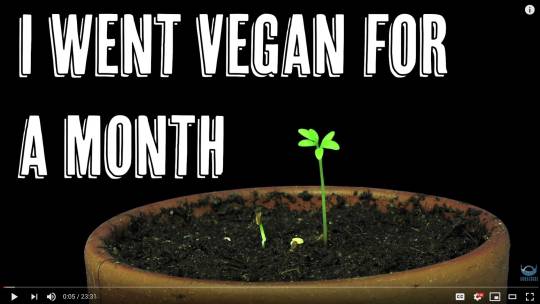
The video (as you can probably guess from the above screenshot) is about the host’s experience trying out a vegan diet for a month.
And as the video progresses, the host runs into a problem with finding vegan desserts he likes. But Daily Harvest, the video’s sponsor, sent him 24 smoothies to help solve his problem:
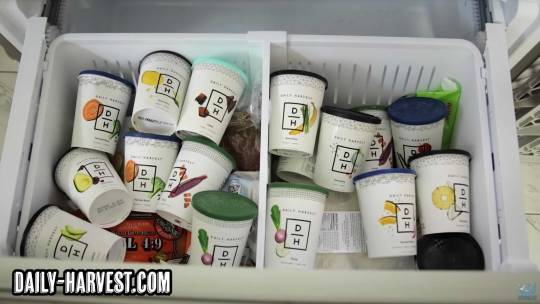
Incredible product placement (this video has been watched 1.5 million times and counting) but it doesn’t end there. In the video description there’s a link to Daily Harvest’s website:
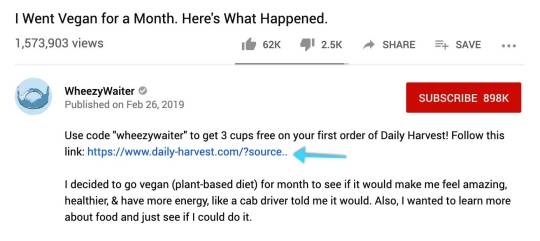
The link also has a UTM specific to Wheezy Waiter so the Daily Harvest team will be able to attribute traffic and sales to this partnership:
https://www.daily-harvest.com/?source=youtube&medium=cpc&campaign=inf&content=wheezywaiter&term=
Breaking down the UTM: Essentially, UTM codes tell the story of how traffic is arriving at a website. Here’s a breakdown of the Daily Harvest UTM:
source=youtube: This tells Daily Harvest the traffic has been referred by YouTube
medium=cpc: Says this was a cost-per-click campaign
content=wheezywaiter: Lets the Daily Harvest team know exactly which piece of content creator the traffic is came from
This is something Daily Harvest has done with a number of well-established YouTuber’s:
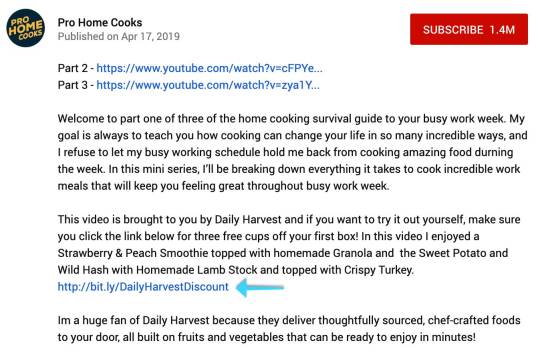
And:

But Daily Harvest’s partnerships aren’t limited to YouTube. It regularly runs Instagram takeovers with influencers and other brands in its stories —
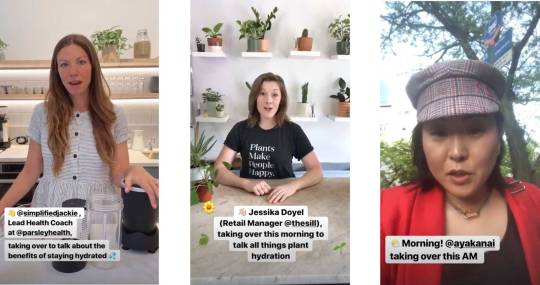
— and it also has an ambassador program enabling people with large followings to share exclusive discounts and coupon codes with their audiences:
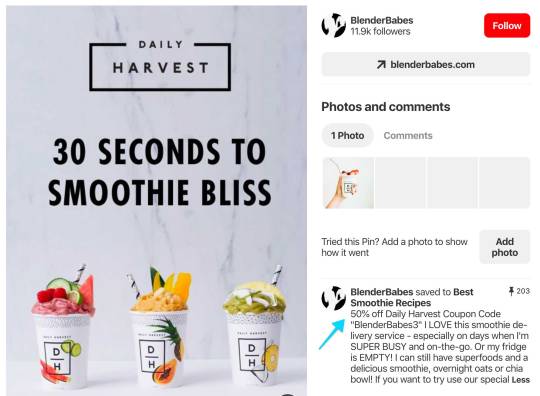
Daily Harvest is also very forthcoming with partnerships. Its website footer features a ‘Partnerships’ link:
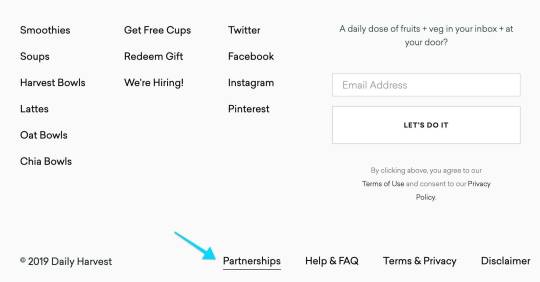
This link then takes people to a simple form where they can register their interest in working with the brand:
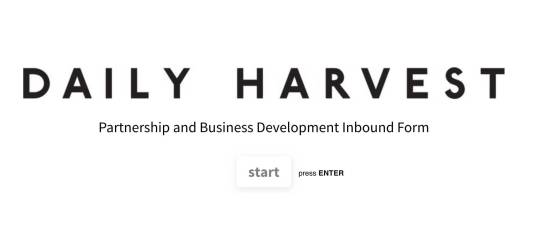
5 Takeaways from Daily Harvest’s journey to 100,000+ customers
1. Understand your target customer’s unmet needs:
Daily Harvest has a clear understanding of who its customer is exactly and what problems it solves for them. This influences how the whole business works: From its product lines to how it positions itself in the market.
2. Use Pinterest as a discovery engine:
Pinterest is a discovery engine for brands. People use Pinterest in ways that mirror how they use magazines and catalogs. By posting relevant content Daily Harvest reaches over four million people per month on the platform.
3. Create a beautiful, simple-to-use buying experience:
Consumers are spoilt for choice now, to stand out you need to create great experiences. Daily Harvest’s website does just that. Its focus on story has also helped the company to pick up some very important backlinks.
4. Drive paid social traffic to specific landing pages:
When using paid acquisition channels (especially on social media), Daily Harvest links to specific landing pages that build on the promises made in the ads.
5. Unlock new audiences through strategic partnerships:
When you’re marketing to new audiences, it’s not so much about reach as it is building trust. Daily Harvest works with partners and influencers to help it establish trust with new potential customers.
Thank 5 Marketing Lessons from Daily Harvest’s Journey to Shipping One Million Smoothies for first publishing this post.
0 notes
Text
World Class Driving Lessons in Pinner
Tips for Drivers for Safe Car Driving
When you’re behind the wheel of a car – whether alone or with passengers – driving safely should always be your top concern. We’re more distracted than ever, so it’s crucial to know the basics of safe driving and practice them every time you’re on the road. Here, some Tips for Drivers for Safe Car Driving:
Drivers must know before you rev up their engines when they go. Well ordered guidelines to get from center A to center B is a driving aptitude. In the event that you direct a guide, your GPS unit or rules to know where you are going and how.
People in the driver's seat must be attentive of what is happening around them. They should reliably look in their rear-view mirrors, side mirrors, left, right and straight. Master driver to propel a sentiment of what is happening around them.
Knowing how to react to a remark completed is as basic as the time when making a beeline to react to the event. How might you turn the wheels when you start sliding on snow? When you have to wallop on the brakes, and on the off chance that they should pump? Manual is the nearest partner of all.

The associate is the best development to protect people. Drivers of the safeguard are careful and comfortable with the way that anything can occur in any heading. Drivers should reliably decide they leave enough space for their vehicles and automobiles before them to stop, if an unanticipated event, even the atmosphere.
Beyond what many would consider possible, except for when the shielded pace is slower. Rate purposes of containment are arranged in the best driving conditions. Deluge, slush, fog, and movement out on the town oblige a less demanding pace confine. Over the flood of movement is moreover a remarkable guideline.
There is no appropriate chance to make phone calls or quick messages while driving. There is no appropriate chance to make phone calls or speedy messages while driving. There is a horrendous time. Try not to do it.
Full developed drivers in all probability finished not hit the brakes to hurl rear end. They were not undermined by driving faster than is shielded. Little by little, progressively and gives a rear end go now and again meet desires. In others, simply back-end prerequisites to calm and trail as needs are.
If you are a student wanting to learn driving then comes at Salaria Friends Driving School. Our main aim is to teach our students to not just be capable of handling a vehicle but to be safer and better drivers. Parents and students alike can be assured that the lesson will be conducted to the highest standard. We provide the World Class Driving Lessons in Pinner. We will teach you the skills, knowledge and attitudes to become a safe and competent road user and overcome driving fears.
For more details please log on to our website
www.salariadrivingschool.co.uk
Contact: +44 7846 498523
Address: The Common, Southall UB2 5JH, UK
#pinner Driving#pinner driving school#driving school#pinner driving lessons#driving lessons#driving tips
0 notes
Text
Driving School near Pinner
Are you seeking for Driving School near Pinner? Get in touch with Salaria Friends Driving School. We offer proficient Driving Lessons all through Pinner in both manual and programmed vehicles. We have exceptionally prepared mentors.
Here you will get the hang of driving with prepared teachers. Driving on the open street with flexibility is as yet a fantasy for some. Driving can be a true feast for the senses, and we often hear of people noting their connection to their vehicle, giving those names and even human personalities.
The goal of any great driving instructional class will dependably be to make protected and guaranteed drivers. Effectively centering one's driving abilities encourages us to offer regard for building important experience and helps keep our roadways that considerably more secure.
Instead of simply teaching you how to your road test, a good driver training program should help develop drivers who are ready for driving in real world situations.

Why Should You Take a Driver's Course?
Not exclusively does driver preparing give an incredible method to begin your driving, yet it sets you up for the exceptional circumstances you'll look on the roadways around the world.
Driver training is additionally an exceptional method to acclimate you with unfriendly street conditions and climate circumstances - like snow and rain - that could impede or lessen your certainty.
Our Accident Prevention Course can enable further to finish your experience. Courses are individualistic in nature, and determination of a balanced course will at last depend upon involvement; drivers with additional time in the driver's seat will profit by more engaged supplemental classes. Depending upon the certainty of each individual driver, we can help you choose which course is the ideal fit for you.
For more details please log on to our website
www.salariadrivingschool.co.uk
Contact: +44 7846 498523
Address:
The Common, Southall UB2 5JH, UK
#pinner#pinnerschool#pinnerdrivingschool#pinnerdrivinglessons#pinnerdrivingclasses#pinnerdrivingtraining#drivingtraining#drivetest#driveclass#southall#hounslow#hayes#unitedkingdom#ashford
0 notes